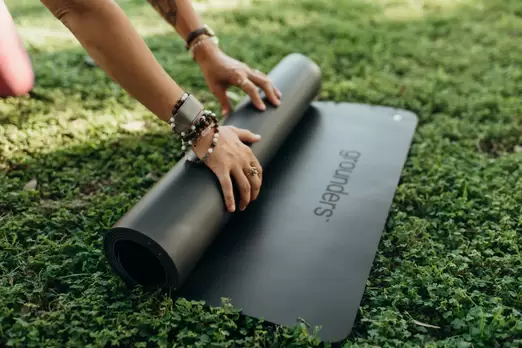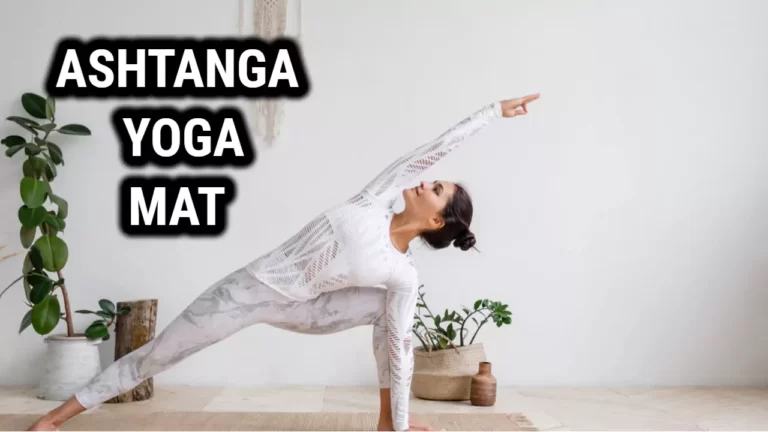How to Choose The Perfect Yoga Mat Thickness
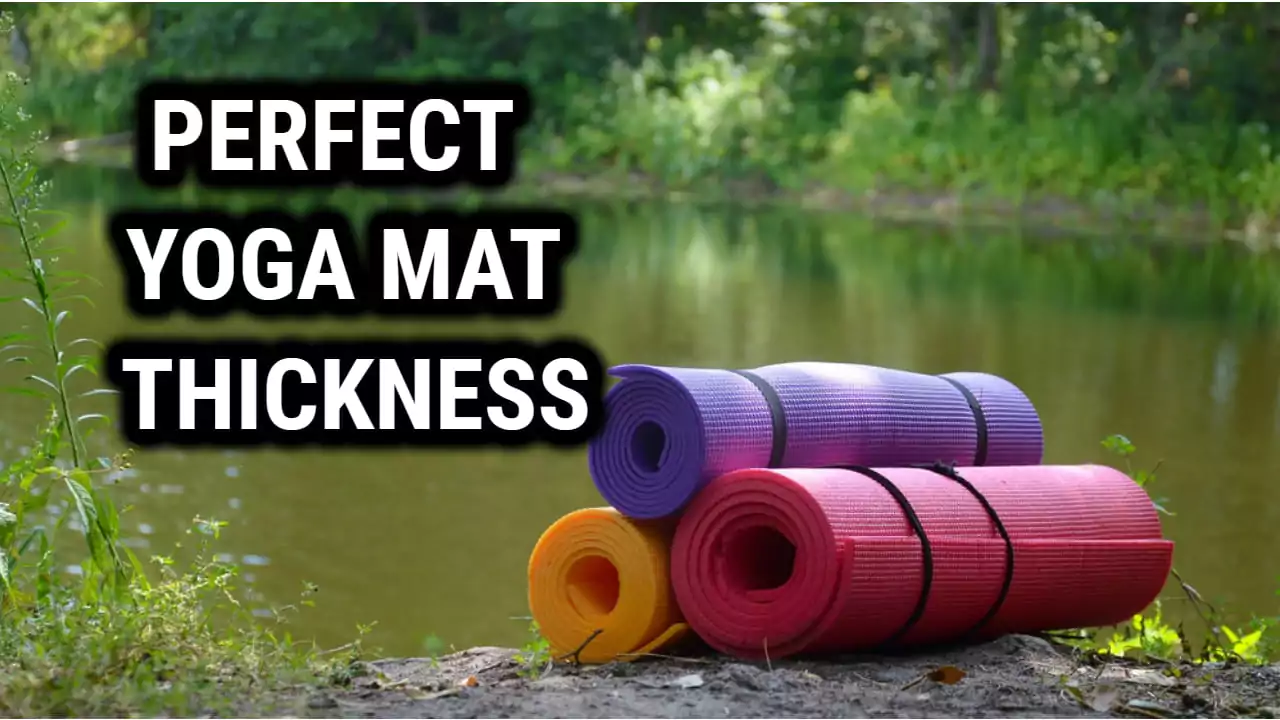
Choosing the perfect yoga mat thickness is an important decision for any yogi. It can make or break your practice and it’s important to get it right. With all the options out there, it can be overwhelming to decide which one is best for you. But don’t worry! In this article, we’ll guide you through the process of choosing the perfect yoga mat thickness so you can start enjoying every moment of your practice.
Yoga mats come in a variety of thicknesses ranging from 1/16-inch to 1/4-inch, and each type of mat offers different benefits depending on your needs. If you’re just starting out with yoga, a thinner mat may be best as they provide more stability and balance when performing poses.
For experienced yogis who need extra cushioning and support, thicker mats are ideal as they absorb impact better and can help prevent injuries due to over exertion.
Now that you have an understanding of what types of mats are available, let’s dive into how to choose the perfect yoga mat thickness for your practice.
We’ll discuss factors like body type, surface texture, weight, and more so that you can make an informed decision that works for you. So grab your favorite yoga gear and let’s get started!
What Is Yoga Mat Thickness?
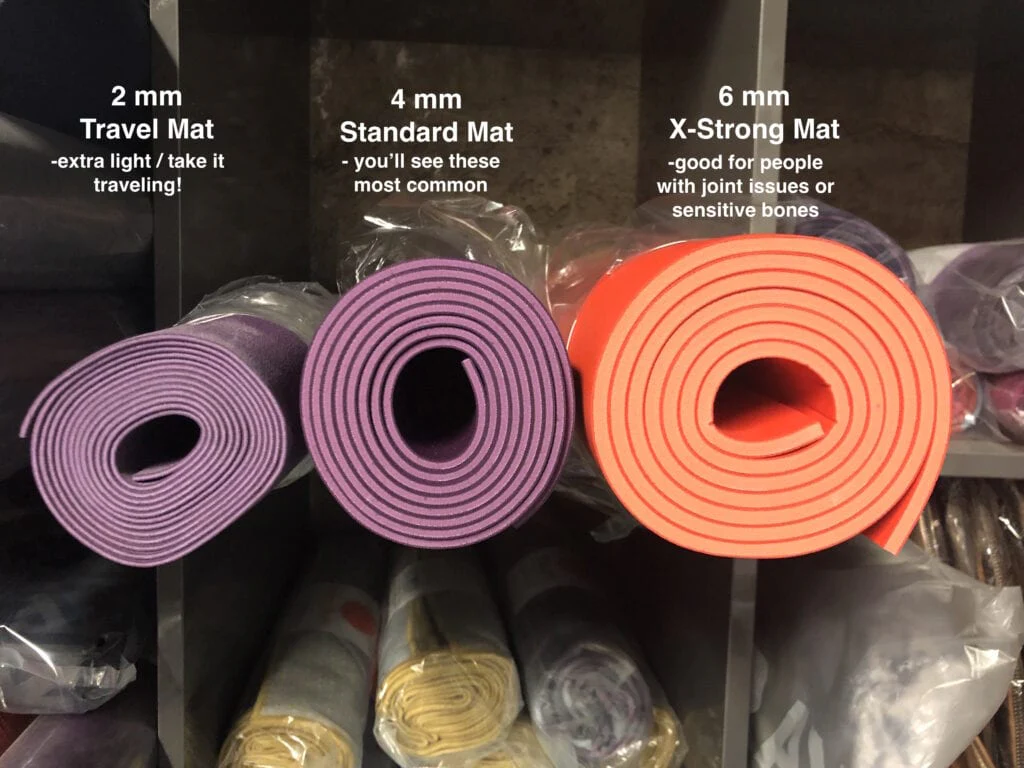
What is Yoga Mat Thickness? When it comes to practicing yoga, having the right mat thickness can make all the difference. It helps ensure you’re comfortable while performing poses and assists with stability. Generally speaking, yoga mat thickness is measured in millimeters (mm) and ranges from 1-8mm.
An extra thick yoga mat will measure between 6-8mm, while a thinner one will be closer to 1-3mm. A natural rubber mat is usually around 4-6 mm thick.
When deciding on the best mat for you, it’s important to consider your size and weight, as well as the type of yoga being practiced. For instance, if you are larger or heavier, an extra thick yoga mat may provide more cushioning and support than a thinner one.
Similarly, if you’re doing more dynamic poses or hot yoga, then a thicker mat can absorb sweat better than a thinner option. So how do you determine which thickness is right for you?
How To Determine The Right Thickness For You
It’s a jungle out there when it comes to choosing the perfect yoga mat thickness. Figuring out what’s best for you can sometimes feel like searching for a needle in a haystack.
To make your life easier, here are some things to consider when selecting the ideal yoga mat thickness that will fit your needs and perform well in your yoga class:
- Determine which type of yoga you practice most often and look for a mat that caters to that style. If you practice ashtanga or vinyasa, then an extra thick, high-cushion mat may be the right choice. On the other hand, if you practice restorative or yin yoga then a thinner mat may be more suitable.
- Consider how much support your body needs while practicing poses and postures. If you have sensitive joints or suffer from chronic pain, then a thicker yoga mat is probably better suited to provide added cushioning and comfort.
- Pay attention to the material of the mat – whether it’s made from PVC or natural rubber – as this can affect its overall thickness and level of cushioning. PVC mats tend to be slightly thinner than rubber mats, so if you want extra padding then go for rubber instead.
- Lastly, think about how often you plan on using your yoga mat and how much wear and tear it will receive over time. If it’s going to get lots of use then opt for a higher quality product with thicker materials that will last longer over time.
With all these factors in mind, selecting the best thickness for your yoga mat should be a breeze! Now let’s take a look at different types of yoga mats and their respective thicknesses so you can make an informed decision when choosing yours.
Types Of Yoga Mats And Their Thickness

When it comes to yoga mats, there are a lot of options available. Different thicknesses can be found for different types of yoga.
- Regular Yoga Mats: These mats usually come in 1/8 inch thickness and are ideal for general yoga practice. They provide the traction and cushioning needed for basic poses and flows.
- Non-slip Yoga Mats: These mats are designed to provide extra grip and stability during your practice. They usually come in 1/4 inch thickness and are great for more vigorous practices, like hot yoga or power yoga.
- Travel Yoga Mats: These mats are thinner and lighter than regular mats, making them more portable. They usually come in 1/16 inch thickness and are great for practicing yoga on the go.
- Eco-Friendly Yoga Mats: These mats are made from natural, sustainable materials and are often biodegradable. They usually come in 1/4 inch thickness and are great for those looking for an eco-friendly option.
- Luxury Yoga Mats: These mats are often made from high-end materials and feature extra cushioning. They usually come in 1/2 inch thickness and are great for those looking for maximum comfort during their practice.
A thicker mat is ideal for restorative or yin yoga, while an extra thick yoga mat may be better suited for more active styles such as vinyasa or power yoga. The thickness you choose should depend on the type of yoga that you practice and your personal comfort level.
It’s also important to consider other factors when choosing the perfect mat thickness, such as the surface you plan to use it on and the amount of cushioning that’s right for you.
When selecting a new mat, take into account what type of yoga you will be doing and how much cushioning you need. If your practice involves more active movements then a thicker mat may be more comfortable than a thinner one.
On the other hand, if your practice focuses more on relaxation and stillness then a thinner mat may work best as it won’t compress too much under your body weight. Consider all these aspects to ensure that you have the best possible experience with your new mat.
Factors To Consider When Choosing Yoga Mat Thickness
When choosing the best thickness for your yoga mat, there are a few factors to consider. The type of mat you choose should depend on the kind of yoga practice you do.
- Comfort: The most important factor when selecting a yoga mat thickness is comfort. If the mat is too thin, it will be uncomfortable and difficult to balance on. If the mat is too thick, it will be too soft and not provide necessary support.
- Type of Yoga: Different types of yoga require different thicknesses of mats. For example, a thicker mat is usually better for restorative yoga, while a thinner mat is ideal for hot yoga.
- Durability: Thicker mats are usually more durable than thinner mats, so if you plan on using your yoga mat for an extended period of time, then it is worth investing in a thicker mat.
- Weight: Thicker mats are usually heavier than thinner mats, so if you plan on traveling with your mat, then you may want to opt for a thinner mat in order to save on weight.
- Price: Thicker mats are generally more expensive than thinner mats, so if you are on a budget, then a thinner mat might be the best option.
If you’re a beginner or doing more gentle yoga, it might be best to opt for a thinner mat made of rubber or PVC with less cushioning. This will make it easier to move around and position your body correctly in each pose.
Ultimately, finding the best thickness for your personal needs is key to having an enjoyable and safe practice!
Choosing Extra Thick Yoga Mats
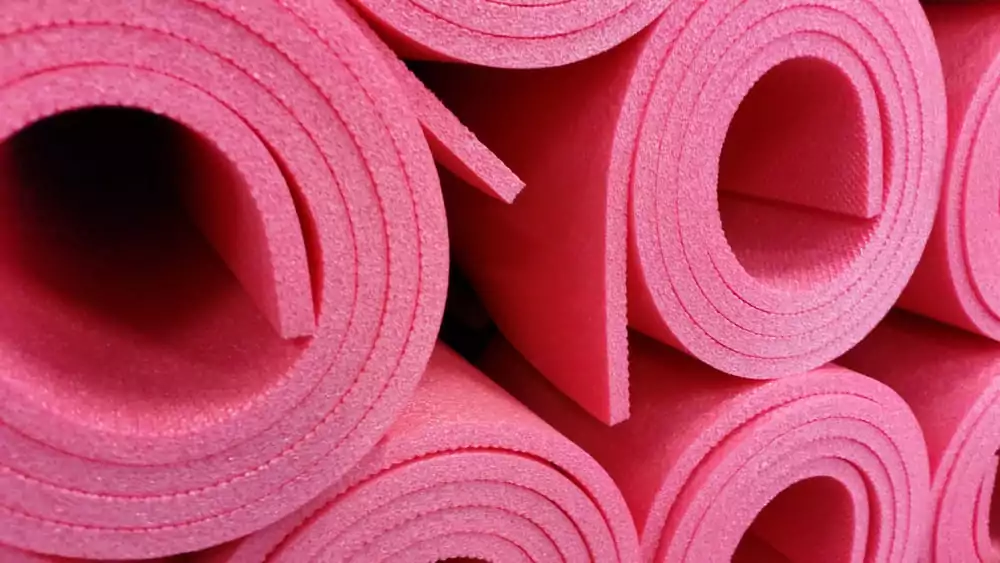
Choosing an extra thick yoga mat is a great way to get the most out of your practice. They provide superior cushioning and support, making them ideal for those who need extra comfort or stability when doing certain poses.
When deciding if an extra thick mat is right for you, it’s important to consider your individual needs – both in terms of the type of yoga you’re practicing, as well as any physical limitations that may be present. You’ll also want to think about how much padding you need from the mat itself.
The thickness for a yoga mat can range from 1/8 inch up to 1 inch. A thicker mat may provide more cushioning and support, but it can also make poses more difficult since it adds more height and weight. That said, if you are someone who has joint issues or likes to practice more challenging postures, then an extra thick mat may be beneficial.
It may also be helpful if you are someone who enjoys practicing restorative styles of yoga where a softer surface is preferred. Ultimately, choosing an extra thick yoga mat will depend on what works best for you and your individual needs.
Benefits Of Thicker Mats
A thick and good yoga mat is like a comforting blanket, protecting you from the cold, hard ground beneath. It provides the cushion and stability needed to push through deep poses without feeling every lump or bump in the floor. With its thickness comes an array of benefits:
- Greater stability and support – A thick yoga mat helps provide a solid foundation while performing even the most challenging poses, allowing practitioners to maintain balance and alignment.
- Comfort – Thick mats provide extra cushioning and comfort for joints, thus helping to reduce pain with certain postures.
- Travel-friendly – Taking your yoga practice on the road? Thick mats are excellent for travel because they offer both protection and support no matter where you go.
- Durability – Thicker mats are more durable than thin ones, making them great for long-term use or studio settings with heavy foot traffic.
These benefits make thicker mats ideal for those who need extra cushioning or stability when practicing yoga, as well as for anyone who wants to ensure their mat can withstand wear and tear over time. Plus, with so many colors and patterns available, it’s easy to find one that suits your style.
Also Read: Best Sustainable Yoga Gear To Use
Reasons To Go Thin
For those looking for a thinner mat, they may be interested in practicing yin yoga or other forms of gentle yoga that require more connection with the floor. A thin mat can also be beneficial if you travel a lot and need something lightweight and compact.
When choosing a thin mat, it is important to make sure it provides enough cushioning and comfort for your body’s needs. If the surface of the mat is too hard, you may find yourself feeling uncomfortable during your practice.
Also take into consideration how much grip the thin yoga mat offers as this will affect how well you stay grounded in your poses.
Thinner mats may also be ideal for those who want to feel more connected to their environment or who want less insulation between them and the ground.
Ultimately, when selecting the perfect yoga mat thickness, consider all aspects of your practice – including what type of yoga you’ll be doing, where you’ll be practicing, and what feels most comfortable for your body – before making any final decisions on thickness.
Finer Details In Thickness Selection
When choosing the thickness of your yoga mat, there are a few things to consider. Yoga mats range from 1/8 inch up to 1/4 inch thick, and understanding which thickness is right for you will help ensure you get the most out of your practice.
- Consider the type of practice: If you practice more active forms of yoga such as Ashtanga or Vinyasa that involve more dynamic movement, a thicker mat may be better suited for cushioning and support.
- Think about stability: Thinner mats may provide more stability and grip on hard surfaces during poses that require balance and precision.
- Contemplate comfort: A thicker mat can provide more cushioning and comfort if you have sensitive joints or body parts.
Choosing the perfect yoga mat thickness comes down to personal preference as well as considering factors such as the type of practice, stability, and comfort.
Different thicknesses will offer different benefits depending on what you need for your practice, so make sure to take these into account before investing in a new yoga mat. With this knowledge in mind, it’s time to move onto another important factor when choosing a yoga mat: travel-friendly mats and their ideal thickness.
Travel Friendly Mats And Their Ideal Thickness
For those who are always on the go, travel yoga mats provide the perfect solution. While they have the same functionality as traditional yoga mats, they are much more lightweight and portable.
However, with this convenience comes a slight compromise in thickness. Extra padding is sacrificed for portability, making it important to choose the ideal thickness for your needs.
Generally speaking, a travel yoga mat should be lightweight enough to carry without too much effort, but still provide necessary cushioning and stability during your practice.
The ideal thickness for a travel yoga mat will depend on your individual needs and preferences; however, most travel friendly mats range from 1/16” to 1/8” thick.
If you prefer extra padding during your practice and don’t mind the added weight of a thicker mat, then look for one that’s closer to 1/8″. Conversely, if you need something that’s ultra-lightweight and portable with minimal cushioning, then go with 1/16” instead.
Related Read: What Are The Best Yoga Mat Alternatives
Frequently Asked Questions
How Much Does A Yoga Mat Typically Cost?
When it comes to buying a yoga mat, the cost is an important consideration. Generally, yoga mats range in price from around $20 up to $200 or more. The type of material and thickness of the mat will affect the cost, so it’s important to do your research before making a purchase.
Eco-friendly materials tend to be more expensive than other materials, but are also often better for your health and the environment.
Thicker mats are usually more expensive than thinner ones, as they offer more cushioning for your body during practice. If you’re on a budget, there are plenty of inexpensive options available that use lower quality materials yet still provide enough cushioning for most poses.
However, if you’re willing to invest a little bit extra in quality, you can find great eco-friendly options that will last longer and make your practice even more enjoyable.
What Are The Differences Between A Yoga Mat And A Regular Exercise Mat?
Yoga mats and regular exercise mats are two different pieces of equipment and are used for different activities. According to recent surveys, 78% of Americans have at least one yoga mat in their home. So what exactly sets a yoga mat apart from a regular exercise mat?
The most obvious difference between the two is thickness. Yoga mats are typically much thicker than regular exercise mats, ranging from 4mm to 8mm.
This extra padding helps cushion your joints as you move through poses and provides more support when performing balancing poses. It also gives you more cushioning on hard surfaces like wood floors or concrete.
Regular exercise mats, on the other hand, are usually only 1-2mm thick and therefore provide less cushioning, which can make it difficult to perform some poses comfortably.
In addition to thickness, yoga mats also feature special grip technology that helps keep them from slipping during practice.
Exercise mats don’t usually have this feature and so can be more slippery when performing certain poses or movements. Finally, yoga mats come in a variety of colors and designs that cater to individual tastes better than regular exercise mats do.
Are Yoga Mats Washable?
Wondering if yoga mats are washable? Fortunately, the answer is yes. Most yoga mats are designed to be easily washed with soap and water. You can purchase special mats that are made of antibacterial materials and are even machine-washable.
However, it’s important to read the manufacturer’s instructions before trying to clean your mat as some materials may require different washing techniques. Additionally, you should avoid using harsh detergents or bleach on your mat as this could cause damage to the material and reduce its lifespan.
After washing your mat, hang it up in a well-ventilated area to dry naturally before using it again. To ensure your mat stays fresh and hygienic, try wiping it down after each use with a damp cloth or an antibacterial cleaning spray.
How Often Should I Replace My Yoga Mat?
On average, yoga mats should be replaced every six to twelve months. This statistic is especially important if you practice yoga regularly, as the mat can become worn out and less supportive over time. To ensure that your practice remains safe and effective, it’s important to stay on top of your mat replacement schedule.
Here are 5 key tips for replacing your yoga mat:
- Clean your mat regularly with a damp cloth or antibacterial cleaner
- Invest in a quality yoga mat that suits your individual needs
- Look for signs of wear and tear like fraying edges or loose fibers
- Consider purchasing two mats so you have an extra one when needed
- Pay attention to how often you’re using the mat to determine when it’s time for a new one
By following these tips, you can ensure that your practice remains safe and effective. Plus, replacing your mat every year or so will keep things fresh and reduce the risk of injury due to unsupportive materials. Investing in a quality yoga mat is essential for any yogi looking to get the most out of their practice.
Are There Any Health Benefits To Using A Yoga Mat?
Are there any health benefits to using a yoga mat? Yes, absolutely! Practicing yoga on a mat offers several health benefits that can be both physical and mental. Here are just some of the advantages:
- Improved posture: A yoga mat provides the padding and cushioning necessary to practice poses correctly. This helps people maintain good form while they move through the poses, which can help improve posture in everyday life.
- Reduced stress: Practicing yoga is known to reduce stress levels, as it helps people become more mindful and calmer. The physical comfort of a yoga mat creates an environment conducive to relaxation, allowing people to better focus on their breath work and release tension.
- Injury prevention: Doing yoga poses on a hard surface can put strain on your joints leading to injury. A yoga mat provides support and cushioning for your body, reducing the risk of injury from slipping or falling during poses.
Using a yoga mat is not only beneficial for improving one’s physical wellbeing but also for cultivating mental wellbeing too. With the right type of support from a mat, practitioners can enjoy peace of mind knowing their body is being taken care of while they practice.
All in all, having access to a quality yoga mat adds another layer of comfort and security when practicing at home or in the studio.
Conclusion
Choosing the perfect yoga mat thickness is an important part of any yoga practice. There are many factors to consider when selecting a mat, such as cost, type, and washability. Additionally, it’s beneficial to replace your mat often to ensure long-term health benefits.
When it comes right down to it, choosing the right yoga mat thickness is like searching for a needle in a haystack. With so many options on the market, you’ll need to do some research to find the one that’s just right for you. You don’t want to be stuck with a mat that won’t hold up or provide the support your body needs during practice.
In short, finding the ideal yoga mat thickness is not rocket science – but it does require some thought and consideration. So take your time and choose wisely – after all, your body deserves nothing less than the best! To put it another way: if you put in a little effort now, you’ll reap the rewards later.



